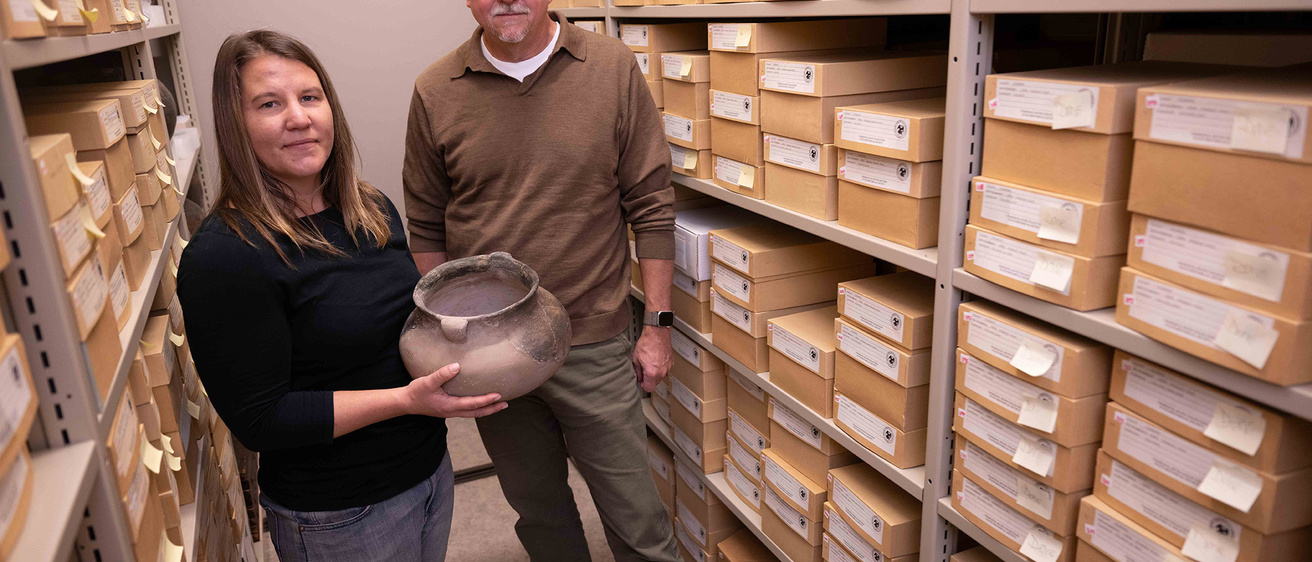The University of Iowa’s Office of the State Archaeologist is tasked with uncovering Iowa’s Indigenous past; however, the most rewarding part for these archaeologists isn’t finding hundreds of artifacts in the ground each year, but making connections with local Native American tribes after returning the remains of a long-lost ancestor.
Established in 1959, the Office of the State Archaeologist (OSA) is one of the older research groups on campus. Its goal is to develop, disseminate, and preserve knowledge of Iowa's human past. The team is led by State Archaeologist John Doershuk, who was appointed to the position by the Board of Regents, State of Iowa, in 2007.
“We are in charge of what's called the Iowa Site File, which is the record of all known archaeological site locations, deposits of archaeological material artifacts and features, which would also include areas that have human remains,” says Doershuk.
The office has more than 30,000 archaeological sites on file, with 200 to 400 being uncovered every year. In 1976, Iowa became the first state in the country to enact a law to protect ancient burial sites. The law created a rolling date for the definition of ancient, so everything 150 years or older is considered ancient and under the responsibility of the OSA.
That timeline means many of these sites mark long-standing Native American occupations, which uniquely connects the UI to Iowa’s Native tribes.
The OSA Indian Advisory Council includes representatives from several communities descendant to Iowa. Through regular meetings, the council members and OSA staff share information and address issues related to ancient burial sites, human remains, repatriation, and other topics.
Members of the council are:
- Joe Coulter, Potawatomi
- Lance Foster, Iowa
- Julie Martineau, Lakota
- Jacki Rand, Choctaw
- Suzanne Wanatee Buffalo, Meskwaki
The state code requires that the OSA have an Indian Advisory Council with at least two Native individuals who are residents of Iowa. The council has now grown to five Native advisors, who meet several times a year.
“Since the majority of the archaeology that exists in the state is of Native American ancestors and because the passage early on of that law protecting ancient human remains, my office works strongly and collaborates with Native Americans about their archaeology,” says Doershuk.
Twenty-six tribes have traced their heritage to Iowa at various times, so when ancient human remains are discovered at an archaeological site, bioarchaeology director Lara Noldner steps in. Noldner, who joined the UI in 2014, serves as the liaison to the OSA’s Indian Advisory Council and is responsible for the protection and reburial of ancient human remains in Iowa.
“Those 26 tribes are the ones we consult with on any ancient human remains found in Iowa,” says Noldner. “I will notify them of our federal Native American Graves Protection and Repatriation Act (NAGRA) compliance, but also will organize the return of remains and reburials.”
Around one to five inadvertent discoveries of ancient human remains are reported annually across the state in places ranging from eroded riverbanks to construction sites. Noldner takes the lead to investigate further and comply with federal and state laws that govern the handling of ancient Native remains.
Findings on campus
Excavation at the current site of the Voxman Music Building unveiled a small piece of Iowa City’s history.
“That location had some very interesting and deeply buried archaeological remains from around the time that Iowa City was being founded,” says Doershuk. “A small settler’s claim cabin was found there, and it was nicely preserved. Trade beads were found, which probably meant that the person was interacting with Native Americans right there on the corner of Burlington and Clinton more than 170 years ago.”
The process of reburials requires transferring the remains to the tribe. Other times, Noldner or Doershuk is asked to participate in a reburial at one of six state-designated cemeteries.
“Sometimes the tribes will take the remains from us, other times they ask that they be reburied at one of the cemeteries, and sometimes they ask us to participate in the ceremony,” says Doershuk. “When you meet with the tribal representatives at one of those locations, you have the privilege of witnessing this emotional experience as the tribes receive their ancestral remains.”
Being part of these memorable events gives Noldner, who has attended more than 15 reburials, a new perspective on the ancient discoveries. She meets regularly with tribes at places like Effigy Mounds National Monument and Blood Run National Historic Landmark to continue the conversations.
“We consult regularly with Native tribes and seek their perspective on how to best preserve these places,” says Noldner. “I learn so much from these meetings and gain a deeper understanding about the ancestors who made these places very special. That’s the most rewarding part of my job.”
